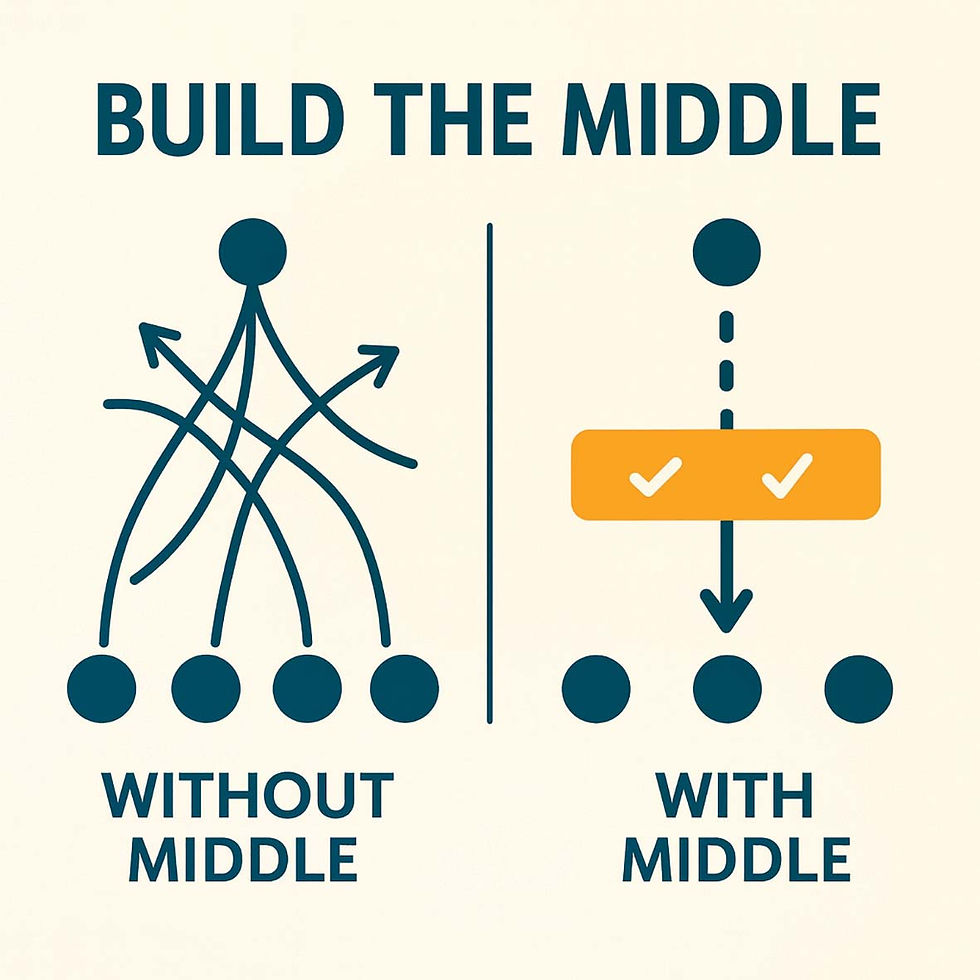From Busy to Owned: Build the Middle
- Rashmi Kulkarni

- Aug 24
- 3 min read
Slug – Business Sense
Last week we explored why growth starts to lurch when every decision still circles the founder. This week is the fix. Make the middle visible so work moves without you.

Monday, 11:10 am.
Sales is celebrating a PO (Purchase Order). Ops is juggling dispatch. Finance is nudging a payment. Three different teams, same pause:
“Who signs off?”
“Ship now or wait?”
“Loop you in, sir/ma’am?”
It’s not speed that’s missing. It’s ownership you can see.
What “the middle” actually means
Not more managers. Not longer meetings. It’s a simple leadership system that tells everyone who decides, when, and where exceptions go:
Role Charters (one page, per manager)
Scope, decisions owned end-to-end, what “good” looks like, and red-line escalations. Short, public, living … so people don’t need to “just check” on WhatsApp.
Decision Ladder (green / amber / red)
Green: Decide & inform.
Amber: Decide with consult (time-boxed).
Red: Escalate with context (into fixed slots).
Post one Ladder per core flow … sales, delivery, support, finance … so polite waiting doesn’t replace action.
Escalation Windows (twice a week, fixed)
Example: Tue & Thu, 11:30–12:00. Stuck work lands here inside the system, not at midnight. Predictable beats urgent.
Published Rhythm (the operating diary)
A weekly review with a standing agenda: WIP lanes, owner tags, next decisions, risks. Visibility replaces supervision; founders can be strategically unavailable.
If that felt abstract, here’s the home-version you’ll recognise.
The Society WhatsApp Test (real version)
9:12 p.m.: “Paani kam aaya.” (Lesser water supply)
By 9:14: 47 messages, one “Good morning” sticker, and three people tagging the secretary. The watchman is now answering calls and switching the motor like a DJ.
Classic no middle.
Now add a small, desi middle: the Water Subcommittee Head plus the watchmen. They ration first, tanker last. A simple playbook: stop–start timings agreed, a ready message (“Supply stop 6–8 am. Conserve water. Update at 8:15.”), and a rule that the Head decides rationing; only if two cycles fail, the treasurer is pinged to price a tanker; the secretary enters only if both steps don’t hold.
Result? Fewer pings, fewer heroics, and full buckets by breakfast. The group goes back to birthday photos. Work didn’t get lighter … ownership got visible.
In teams, the same logic turns polite waiting into steady motion.
How the shift becomes visible
Instead of a before/after story, here are signals you’ll notice in 10 days when the middle is working:
Fewer “Can you just see this once?” pings.
Standups end with named owners and time-boxed decisions … not updates.
Amber items stop floating; they’re decided within the window.
Red items wait for the slot unless truly urgent (and urgent is now rare).
People start saying, “I own it,” without adding, “unless you want to review.”
No fanfare. Just steadier motion.
How to install it (Indian SME reality)
Day 1–2: Pick one friction lane (onboarding, change requests, month-end collections).
Day 3–4: Draft two Role Charters for your natural “catchers.” One page. Read them aloud in the team meet.
Day 5–6: Mark 10 typical decisions as Green/Amber/Red. Time-box amber consults (e.g., 24 hours).
Day 7: Announce two Escalation Windows on the shared calendar. If it’s not red, it waits.
Day 8–10: Run the rhythm. Daily WIP = owner tags + next decisions; weekly ops = risks + handoffs. Founder attends only if a red-line is hit.
Track two simple numbers before/after: after-hours messages and cycle time. If both drop, the middle is taking hold.
When it wobbles (and it will)
Charter drift: If managers still seek blessings, your red lines are too generous; tighten the Ladder.
Window spillover: If escalations leak to DMs, add a third temporary slot and sort by type.
Review theatre: If meetings become status shows, cut to four beats: WIP, owners, decisions due, risks.
Rashmi’s note
Headcount adds capacity. The middle adds speed. It’s not culture decks or tool rollouts. It’s the quiet confidence that comes when “who decides” is public … and exceptions have a place to go. That’s when teams stop waiting for the founder and start moving on time.
Next week, Rahul explores restraint: why presence can quietly slow execution unless exits from loops are designed in.
(Rashmi Kulkarni is Co-founder at PPS Consulting. She works with growth-stage teams to install operating rhythm and clear decision rights so work moves without supervision. Views are personal. Write to rashmi@ppsconsulting.biz or connect on LinkedIn.)




Read more deep-dive insights at www.ppsconsulting.biz/blog.